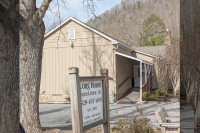With formulation of advisory committee, efforts to regulate growth along Hwy. 441 are well underway
By Jennifer Garlesky • Staff Writer
At speeds faster than 50 mph, drivers zoom down U.S. 441 into Cherokee’s business district, passing mostly billboards, a couple of gas stations and a few small businesses. The two-mile stretch of roadway is heavily used by locals and tourists, accommodating about 15,000 cars a day. Some use it to get to the entrance of the Great Smoky Mountains National Park or the Blue Ridge Parkway, others make it their gateway to Harrah’s Casino and downtown Cherokee, while for many it’s just part of their daily driving route.
Residents like Martha Catolster of Cherokee call this section of roadway a “racetrack” because of the numerous speeding cars.
“You notice every year traffic around here increases,” Catolster, 54, said as she watched cars pass while standing outside the Dollar General Store along U.S. 441.
Only one stop light at the intersection in front of Smoky Mountain Elementary School slows drivers for a brief stint before getting to their desired destination.
“A lot of people come in here and use this road as a raceway to get between here and Cherokee,” she said. “You more or less have to take a chance anytime you pull out.”
Related Items
Catolster’s feelings about the roadway are shared by others. Jackson County Commissioner William Shelton, who represents this area of Jackson County and lives nearby, expressed similar concerns.
“It’s like playing Russian Roulette,” he said. “I am waiting for the phone call telling me my parents got hit while pulling out.”
Traffic congestion along the corridor is expected to just keep increasing over the next few years as water and sewer lines attract retail and big box developers to this rural area. Next summer the Whittier sewer plant will be completed, which has real estate developers posting “land for sale” signs along the undeveloped valley.
Jackson County leaders are taking a proactive approach to prevent the corridor from turning into a Gatlinburg-type congested area, where there has been so much concentrated growth that it’s a hassle for drivers to travel from one side of the town to the other. The trick is to guide growth without stopping it.
“Whether it be traffic lights or access roads, I don’t want to get in a situation where we are limiting growth,” Commissioner Brian McMahan said. “I want this to be an open area that you can travel through without delays.”
Commissioner Tom Massie agreed.
“I don’t want it to turn into Pigeon Forge where there is a stop light every five feet,” he said.
Last month commissioners hired the Raleigh based consulting firm Kimley-Horn & Associates to develop a protection ordinance and a land preservation report for the corridor. Over the next six months, project managers Matt Noonkester and Mike Rutkowski will be roaming around the corridor and mapping from U.S. 74 and the Great Smoky Mountain Expressway to the Qualla Boundary.
“Right now we are in the phase of research and collaboration,” Noonkester said.
The two were in Jackson County last week and met with county officials and committee members to develop a vision statement for the project, which will address the corridor’s transportation and environmental issues, urban design and landscaping.
In January the firm will unveil its work at a five-day public meeting where community members will get the opportunity to state their dislikes and likes about the corridor’s proposed master plan.
Regulating development
Assisting the firm in the process is an eight-member advisory committee comprised of Qualla community members and representatives of the Eastern Band of Cherokee Indians.
Committee member David Ferguson decided to serve on the committee because he owns two tracts of land that adjoin U.S. 441.
“I would like to know where they are going to put curbing and commercial businesses,” the 67 year-old livestock farmer said.
Ferguson supports the commissioners’ decision to conduct a study as a way to regulate growth. He says he would like to see some guidelines set forth for developers.
“I know I can’t control it. I would just like to see it developed in a controlled way,” Ferguson said.
Jerry McAbee of Whittier is another advisory committee member and is also concerned about the potential commercial development.
“I am mostly concerned about orderly development,” he said. “With the water and sewer lines coming in there is a lot of pressure and I would like to have a little input in the situation,” he said.
McAbee is excited about the fact that county commissioners are getting the community involved in the study’s process.
“I think it’s fantastic,” he said. “It shows excellent foresight not only for the environment but the people who live there.”
“It’s going to be an economic spurt to the community, and everybody can benefit. It just needs to be done in an orderly manor so that no one’s hurt negatively,” he said.
From now until the public meeting in January, committee members will work closely with the consulting firm. Once the study’s vision statement is developed, members will be emailed the information and the committee will come together as a whole to review the proposed master plan, he said.
Noonkester says having a committee comprised of community members will make for a better plan.
“We feel that will be a great sounding board for the study,” he said.
The tribe’s point of view
The potential growth of the corridor might bring additional economic success to Cherokee. Tribal officials have already gone on the record stating that a partnership between county leaders and the tribe is crucial for the development of this area.
Tribal leaders have a vested interest in this section of roadway because it will be the entrance to Cherokee’s planned Sequoyah National Golf Club. Tribal workers are currently clearing land for a entrance road and construction plans call for the facility to be completed sometime in 2009.
Two members on the advisory committee represent Cherokee — Jason Lambert and Calvin Murphy. As a former retired tribal employee, Murphy says that he will be able express the tribe’s vision for the corridor’s development.
“I would like to see the corridor developed in a manner that would be economically beneficial to the tribe and the county,” he said.
Murphy, who drives the corridor every day, would like to see sidewalks installed along the roadway with a bike lane and some landscaping.
“Just make it look good,” he said.
Seeing that the tribe’s and community’s needs are meet is also another priority of Murphy’s.
“It needs to be really developed to the people that live on it and the people that visit it,” he said.
Maintaining the rural character of the corridor is another objective.
“I want people to have a good feeling when they exit it,” he said.
But some tribal members say the study will not stop growth, even with tribal members being involved in the study’s process.
Rory Gunther, who lives on the reservation and is married to an enrolled member, supports the commissioner’s effort to regulate growth but is skeptical.
“I doubt it will do anything,” he said.
He says that projecting the future growth of an area is difficult.
“Nobody knows what will happen in 15 years, let alone five,” he said. “We got sort of a boom town type of problem — it’s hard to predict.”
Tribal member Mike Lambert shares similar views about the study.
“It will probably end up just being like (Gatlinburg). People like to have things that are convenient,” he said, standing outside the Food Lion on the reservation.









